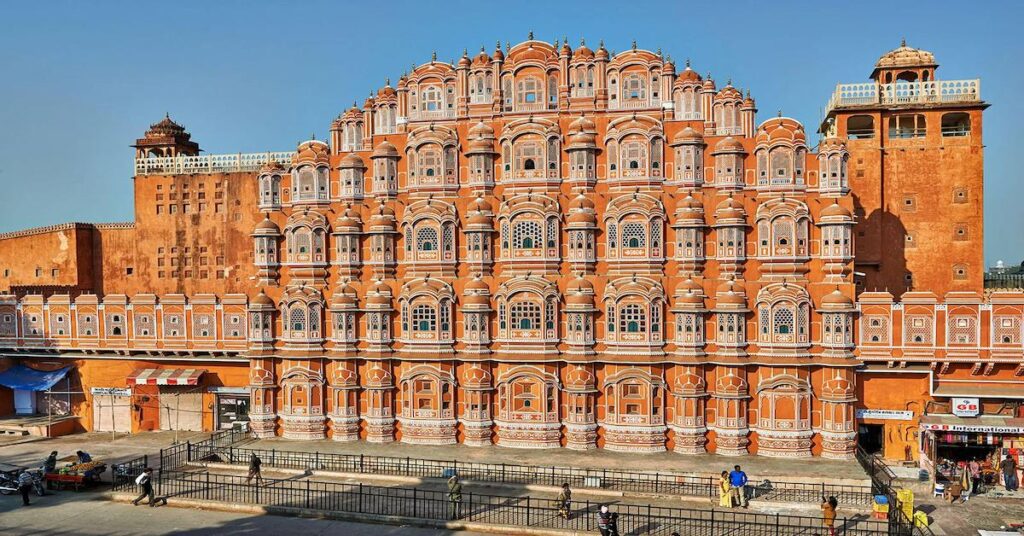The prestigious ‘Castle Of Winds’, or Hawa Mahal, is one of the unmistakable vacation spots in Jaipur city. Situated in the core of Jaipur, this delightful five-story castle was developed in 1799 by Maharaja Sawai Pratap Singh who had a place with Kachhwaha Rajput tradition. The principal planner of this royal residence worked of red and pink sandstone, is Lal Chand Ustad, and the castle is accepted to have been developed as the crown of Krishna, the Hindu god. It is one of India’s most recognizable buildings and popular tourist attractions.


Credits: Britannica
History of Hawa mahal.
It was in 1799 that the Kachhwaha Rajput ruler, Sawai Pratap Singh, grandson of Maharaja Sawai Jai Singh who fabricated Jaipur, developed the Mahal as a continuation of the Royal City Palace. Sawai Pratap Singh’s commitment to Lord Krishna is obvious in the castle’s development as it looks like the master’s crown.
However many reasons are referred to behind the development of the post, Purdah framework followed by the Rajputs is supposed to be one of the primary drivers. During those days, Rajput imperial ladies didn’t show up in that frame of mind before outsiders.
Notwithstanding, they were quick to follow the everyday occasions and illustrious parades happening in the city. It is for their advantage that the Mahal was assembled, and finished with little windows and screened overhangs. This provided the ladies with a feeling of opportunity, without showing up in broad daylight.
Architecture of Hawa mahal.
The architecture of Hawa Mahal planned as a bee colony palace with little windows, has a level of 50 feet from its base. This construction, raised on a flimsy safeguard or platform roughly fifty feet high, has walls under a foot thick. Built of red and pink sandstones by Lal Chand Ustad, Mahal is renowned for its windows or ‘Jharokhas’ which empower the free flow of air inside the design.
Its entry is an entryway that prompts an open patio encompassed by two-story structures on three sides. Of the five accounts of the Mahal, the main three stories have the thickness of a solitary room while the base stories have patios.
The inside of the Mahal is distinct and plain with entries and points of support coming to the popular narrative. The structure doesn’t have steps to arrive at the upper floors; the tales are associated with slants. And you have a great perspective on the city. The landmark additionally has an archeological exhibition hall.
Facts of Hawa mahal.
- It was implicit in the state of a crown, it seems to be Lord Krishna’s crown. Sawai Pratap Singh was accepted to be an extraordinary enthusiast of Lord Krishna. His energy turned into the explanation for this plan.
- It implies the ‘Castle of Winds’ or the ‘Wind Palace’. It has 953 little windows (Jharokhas), which were worked to keep the breeze blowing inside the castle. It was a mid-year retreat for the majority of Rajput families during times past. It is one of the significant attractions in Jaipur.
- It doesn’t have an immediate entry; one needs to enter from the side of Royal City Palace. The Mahal worked in an area of the City Palace, so there was no entry from outside.
- Hawal Mahal has 5 stories and there are no steps to move, rather there are just slopes to arrive at the highest levels.
Conclusion.
There are various tourist attractions around Hawa Mahal, for example, the acclaimed Jantar Mantar, Govind Devji sanctuary, Amer Fort, Nahargarh Fort, Ram Niwas Bagh, BM Birla Planetarium, Jain Temple, Statue Circle, and Sisodia Rani Garden, etc. Hawal Mahal, which is the pith of Rajput design, stands high in the core of Jaipur city as a conspicuous fascination.
Credits: Landmarks
